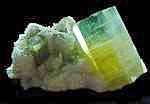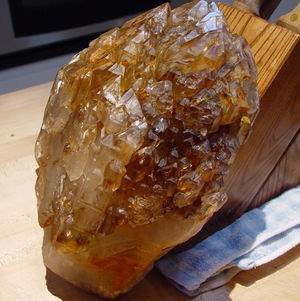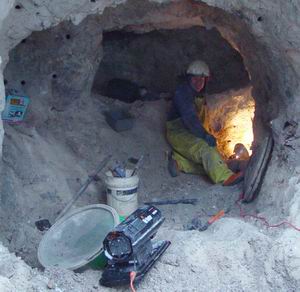

 |
 |
| Mining Operations at Mount Mica & Orchard Pit Mines, Oxford County, Maine. | |

|
The trip to Now, with the holes drilled, we loaded and shot two of them. With anticipation mixed with trepidation, we returned to see the results of this small blast. Strewn out on the floor of the adit was quite a bit of lepidolite, some mica books, the usual quartz and feldspar, and a few spodumene fragments.  What wasn't there was a dark area
marking the
portal of a cavity. In hopes of finding it with hand tools, we got busy
with hammers and chisels. After and hour or so, even though we had
found a few small vugs, we had not found the hoped for cavity. We
could, using our fingers, tease out crumbly material on the far right
bottom of our freshly blasted area. Frustration and worry was building.
Was the accumulated water we had so carefully measured the last time
simply surface water leaking through the many cracks in the overburden
and pegmatite? For a moment or two we sat there dejectedly discussing
whether or not we had managed to dupe ourselves. This period of
deflation was reminiscent of the end of the last advance, where in a
final desperate burst of hammering we opened the water flow. We decided
to continue to chisel and pound on the lower right wall. Almost as if
the pegmatite had decided that it had toyed with us long enough, the
tone of the hammer blows on our chisels shifted from a high pitched
metallic ring to a duller more hallow sound. Like the sound one hears
when your back is thumped. Richard and I, being somewhat old hands at
this by now, merely glanced up knowingly at each other and traded the
tools back an forth as each of us became tired hammering stooped over
on our knees. The hallow sound became even lower pitched and finally
one of the hammer blows, rather than recoiling back, broke into a
space. The hole this strike had opened was only a
couple of inches in diameter. Each of us in turn pressed our cheek down
on the adit floor and tried to peer into the space. We could see
nothing other than darkness. I then asked Richard to pass me the pocket
pry bar. Threading it into the hole, it went unimpeded up to the
handle. As I waved it around in the pocket a clack clack sound came out
and I could move unseen lumpy objects around. We were finally in pocket
28! With the tension broken, we both started to slowly laugh, the
laughter building in intensity to a point where someone who may have
come onto the scene at this point would wonder whether we were
certifiable or possibly suffering from ‘bad air’. What wasn't there was a dark area
marking the
portal of a cavity. In hopes of finding it with hand tools, we got busy
with hammers and chisels. After and hour or so, even though we had
found a few small vugs, we had not found the hoped for cavity. We
could, using our fingers, tease out crumbly material on the far right
bottom of our freshly blasted area. Frustration and worry was building.
Was the accumulated water we had so carefully measured the last time
simply surface water leaking through the many cracks in the overburden
and pegmatite? For a moment or two we sat there dejectedly discussing
whether or not we had managed to dupe ourselves. This period of
deflation was reminiscent of the end of the last advance, where in a
final desperate burst of hammering we opened the water flow. We decided
to continue to chisel and pound on the lower right wall. Almost as if
the pegmatite had decided that it had toyed with us long enough, the
tone of the hammer blows on our chisels shifted from a high pitched
metallic ring to a duller more hallow sound. Like the sound one hears
when your back is thumped. Richard and I, being somewhat old hands at
this by now, merely glanced up knowingly at each other and traded the
tools back an forth as each of us became tired hammering stooped over
on our knees. The hallow sound became even lower pitched and finally
one of the hammer blows, rather than recoiling back, broke into a
space. The hole this strike had opened was only a
couple of inches in diameter. Each of us in turn pressed our cheek down
on the adit floor and tried to peer into the space. We could see
nothing other than darkness. I then asked Richard to pass me the pocket
pry bar. Threading it into the hole, it went unimpeded up to the
handle. As I waved it around in the pocket a clack clack sound came out
and I could move unseen lumpy objects around. We were finally in pocket
28! With the tension broken, we both started to slowly laugh, the
laughter building in intensity to a point where someone who may have
come onto the scene at this point would wonder whether we were
certifiable or possibly suffering from ‘bad air’. Of course our next move was to widen the hole so that we could see inside. In a few minutes the entrance had been widened to 12 inches or so. Now we could see. One of first things we saw was a large parallel growth smoky quartz crystal sitting on top of a heap of pocket material. Our hole was just large enough to induce the pocket to give birth to this crystal. Once we got it out, though it was rust covered, we could see elbaites with black caps attached to its side. The pocket walls were studded with large quartz crystals. A cookeite sand covered the floor. Embedded in this sand was hundreds of fragments of elbaite. Most were colorless or pale pink. There were many terminations too. These were either green pyramidals or black basals.
 Some of the early material from pocket 28 We spent several days emptying the
chamber we had opened. Its dimensions eventually expanded to 2
meters in length by 1 meter in depth. Once the pocket was close to be
worked out, we began to look for additional chambers. As we explored it
in the downip direction and removed some quartz crystals we opened
another chamber that at first appeared to be quite small. Once we
had removed some of the roof, our opinion changed radically. We
were able to insert our 8 foot loading pole nearly all the way.
This chamber would eventually be dubbed the passageway.
Go to Page 3 |